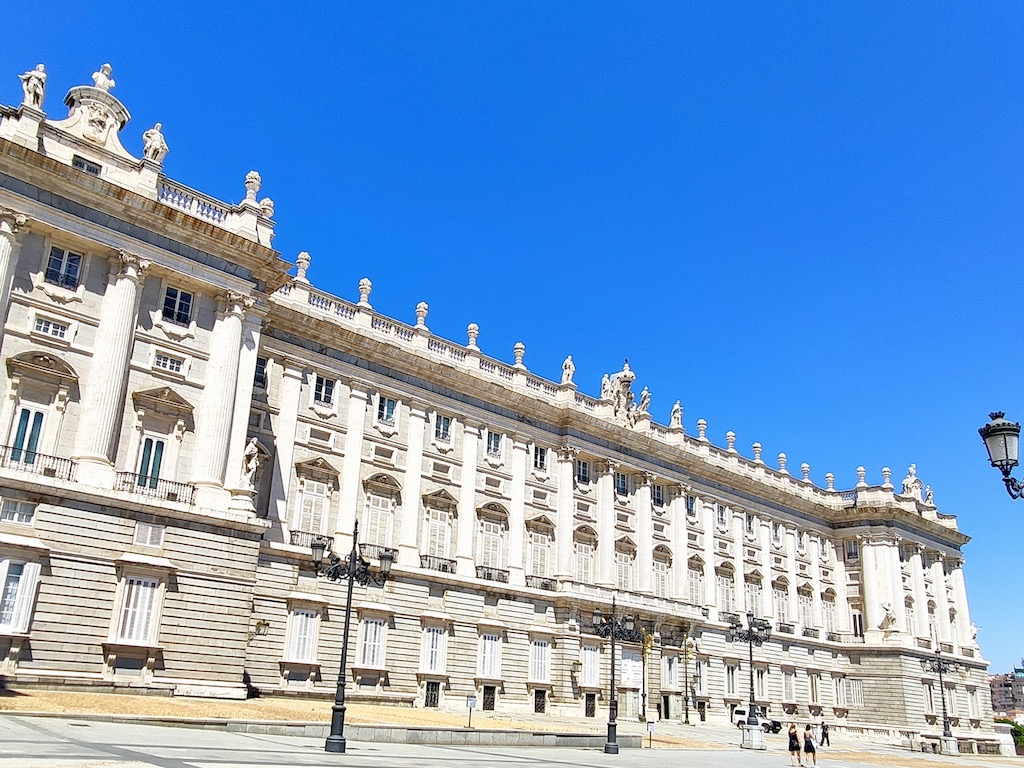

The Royal Palace of Madrid, with over 135,000 square meters and 3,418 rooms, is the largest palace in Western Europe and one of the largest in the world. It is one of the few official seats of a Head of State open to the public.
Their Majesties, the King and Queen of Spain, use it regularly for audiences and official events. The royal family no longer resides there even though it still is their official house.
From the medieval Alcazar to the Royal Palace
The actual royal palace was rebuilt in the 18th Century by Philip V’s order at the Alcazar of Madrid’s location, the old Moorish castle destroyed by a fire on Christmas Eve 1734. Since 1561, this medieval fortress was the official residence of Spain’s kings after Philip II transformed it into a luxurious palace. Unfortunately, the building and all the works of art it housed were reduced to ashes.
Legend has it that the then King ordered the fire. He was of French origin and wanted to rebuild a French palace in Versailles’ style. But as historians have never been able to prove it, no one will ever know!
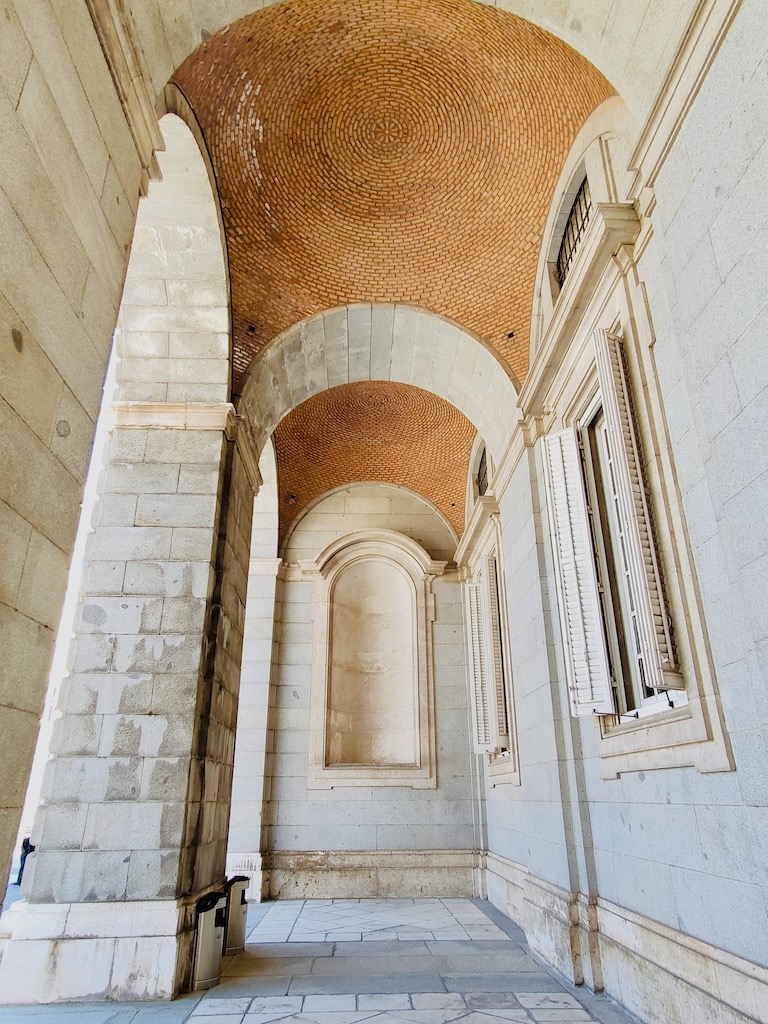

The reconstruction began with the first stone in 1738 and was completed in 1751. It took another eight years to complete the decoration of the surrounding areas.
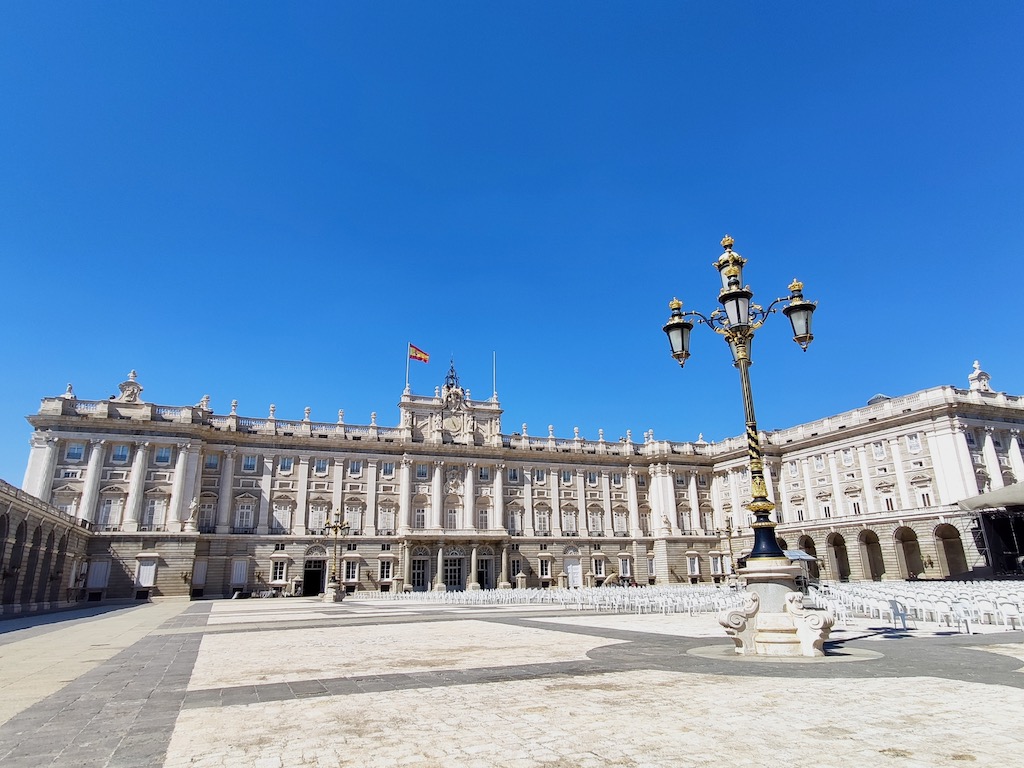

The rectangular-shaped palace is built around an inner courtyard.
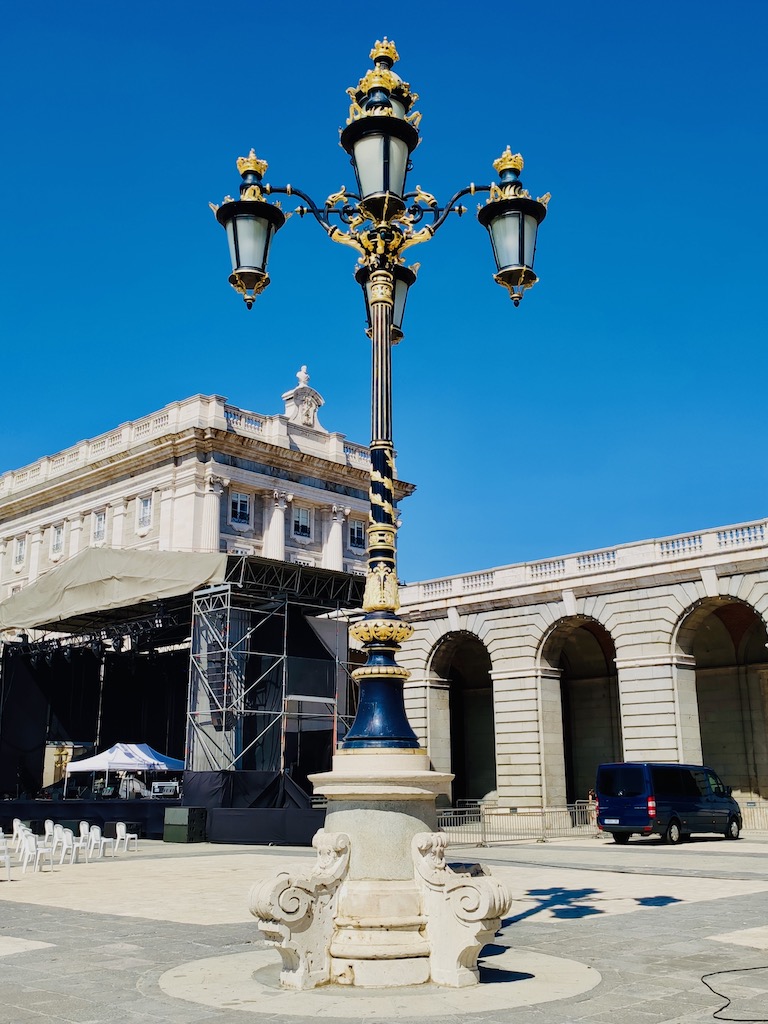

Of course, this splendid building will remain the Kings of Spain official residence, but it will also become the government offices’ seat.
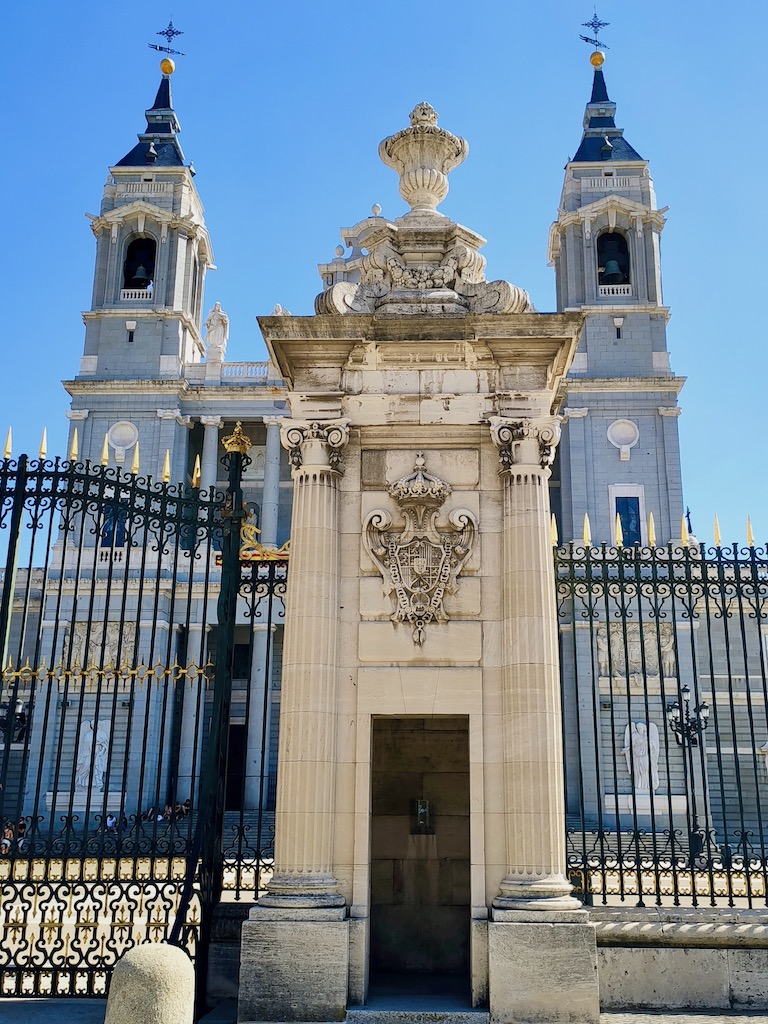

From the palace’s courtyard, a magnificent view of the gardens “Campo del Moro” with the “Casa de Campo” park in the background.
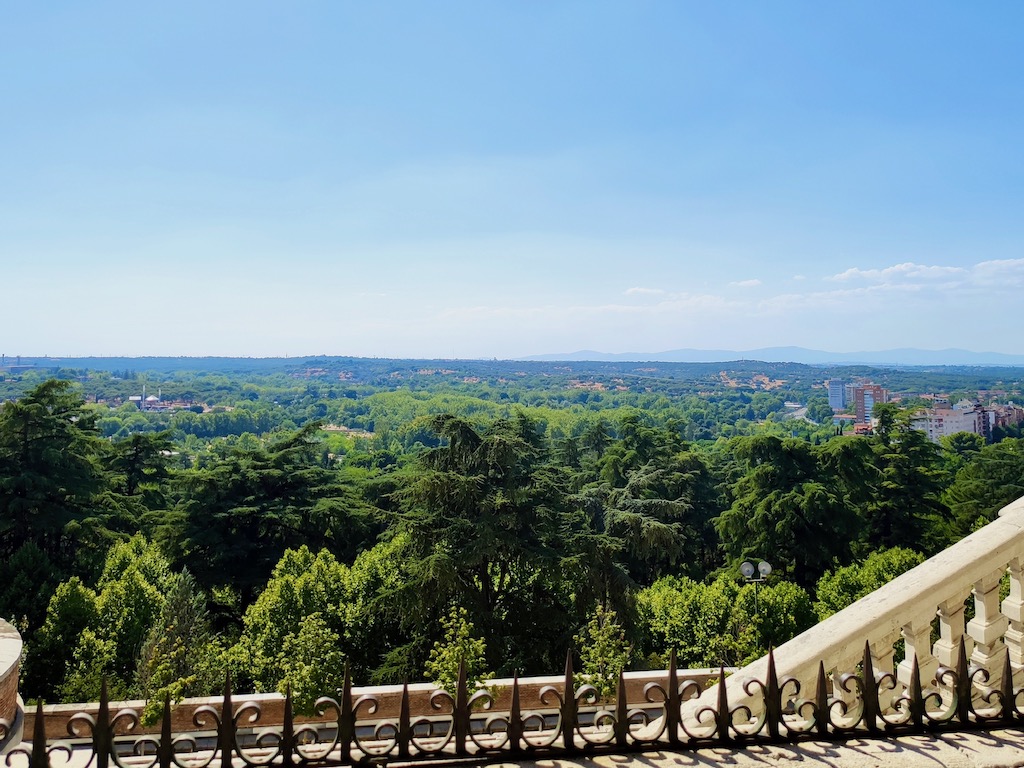

A tunnel then linked ” Campo del Moro” to the “Casa de Campo” park, now Madrid’s main urban park, but which was then a hunting reserve for royalty.
Charles III first inhabitant of this new palace
This king was nicknamed the “Best Mayor of Madrid.”
It was not until 1764 that a King inhabited the Royal Palace for the first time. For the occasion, the most famous Italian painters were brought in to decorate the residence, and it will then experience its most extraordinary splendor.
Despite this, Charles III and his son Charles IV lived there only eight weeks a year. In December, Easter week, and part of July. The rest of the year, they preferred to retreat to the other Crown Palaces: El Escorial, Aranjuez, and La Granja.
Visit of the Royal Palace of Madrid
This visit made us discover richly decorated rooms and the storage of the royal armory.
The palace was simply magnificent. Each room we passed through was unique. They reflect an era, a fashion, and the monarchs’ taste who succeeded and personalized a part of the palace. The styles are completely different, and the whole is impressive.
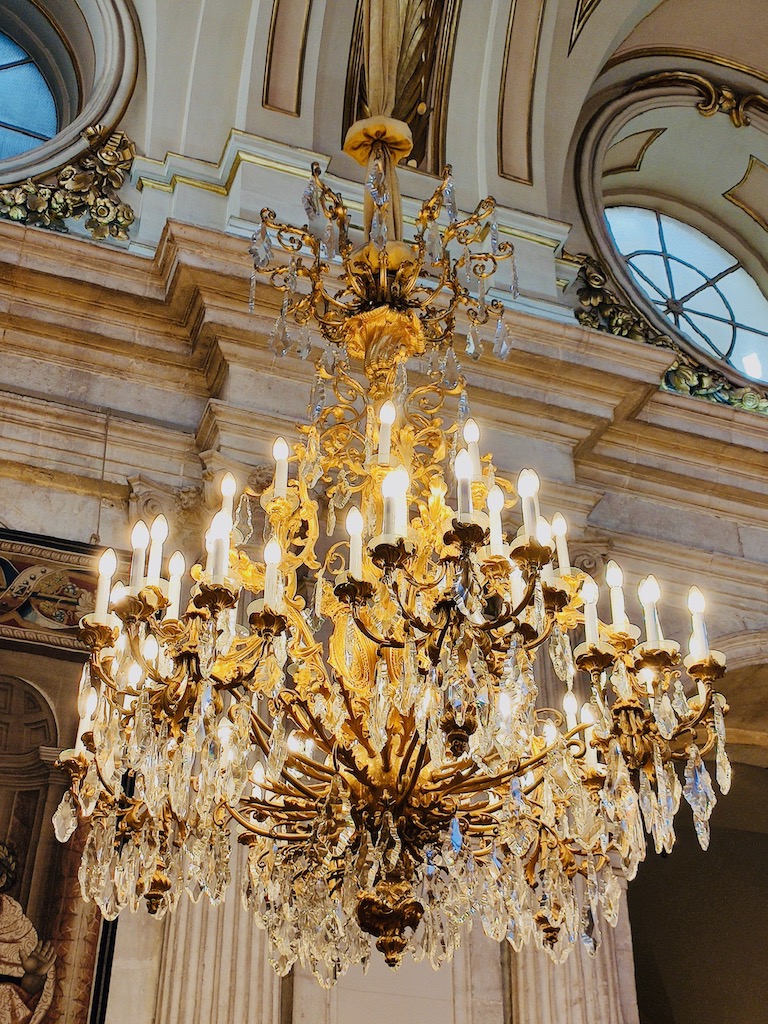

The quarters of King Charles III are in a classic baroque style.
He is also responsible for the decoration of the throne room and the so-called “Gasparini” salon. In an exuberant rococo style, it was his official dressing room.
Charles IV created neoclassical sets with pieces of French furniture.
Ferdinand VII brought with him the French bronze and crystal chandeliers.
And in 1879, Alfonso XII was the instigator of the last decorative renovation.
The result is astonishing!
The Great Staircase and the Hall of Halberdiers
The Great Staircase
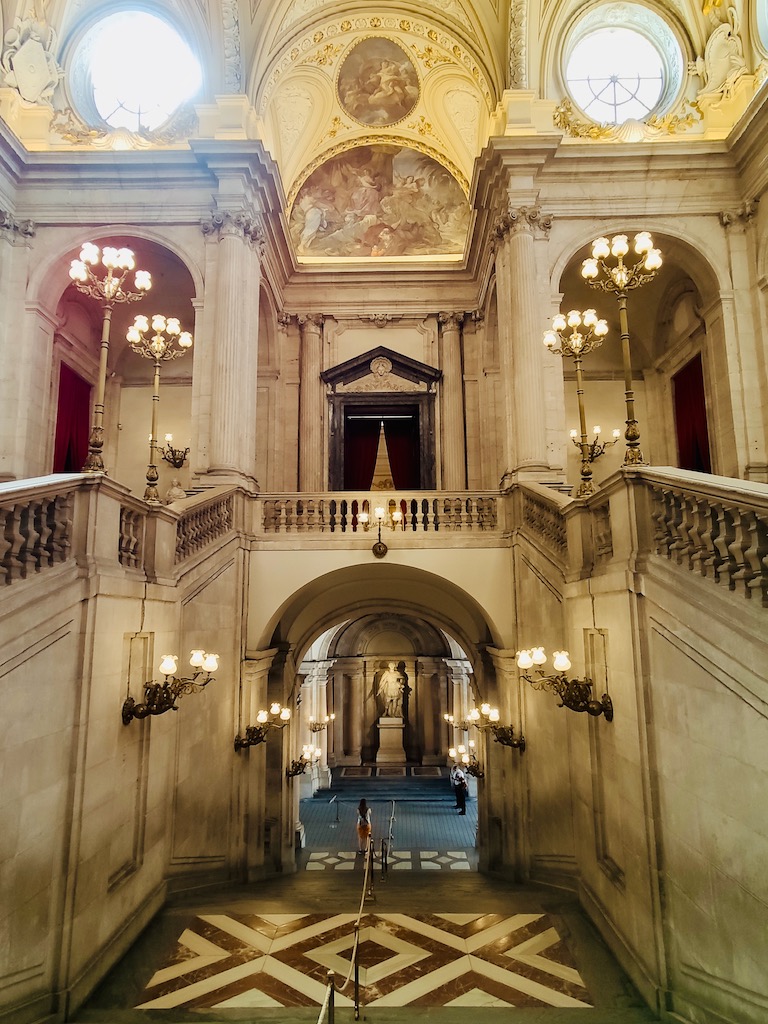

It was at the foot of this staircase that coaches dropped off their visitors.
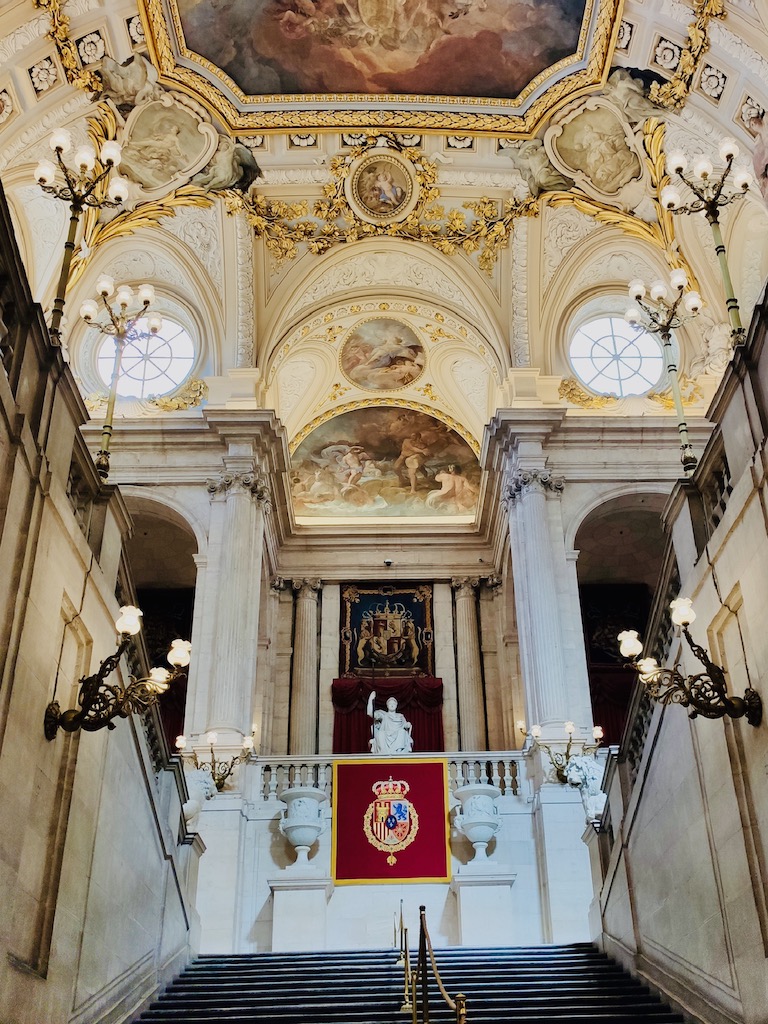

As soon as they arrived, they faced the statue of Charles III as a Roman general.
Two twin staircases start on each side of this central staircase — the right one for the King and the left one for the queen. The initial height of their steps was criticized and sparked controversy despite the marvelous design. And yet, they had been designed to make the climb as comfortable as possible.
We reached the first hall of the palace, always amazed by what we see.
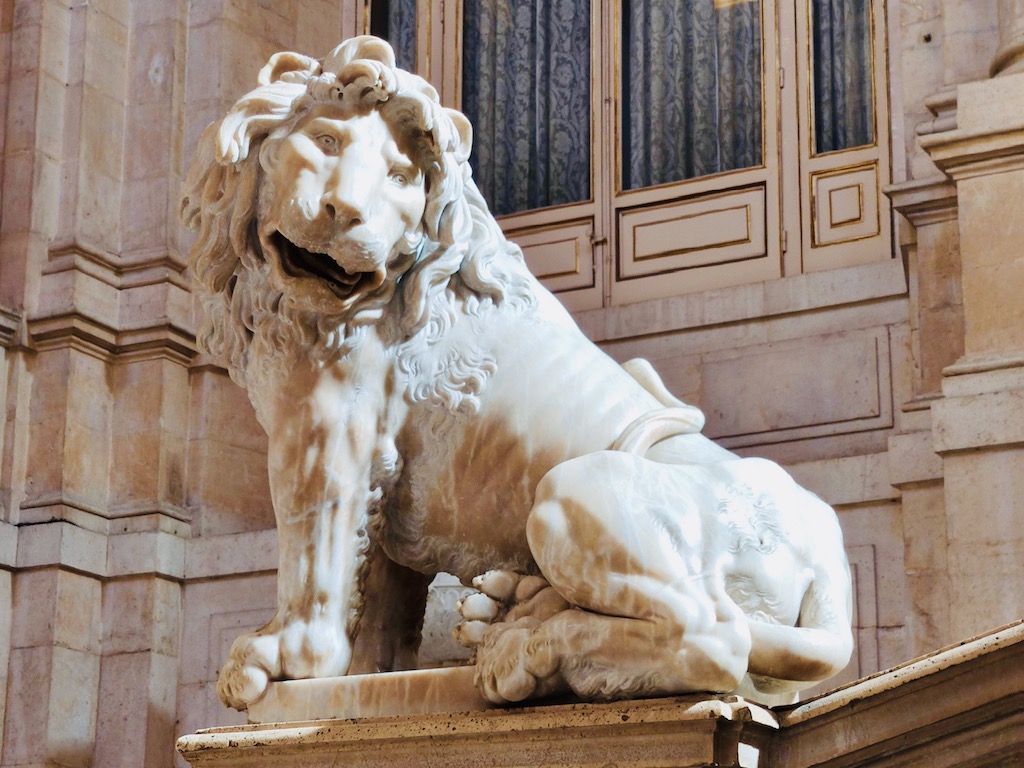

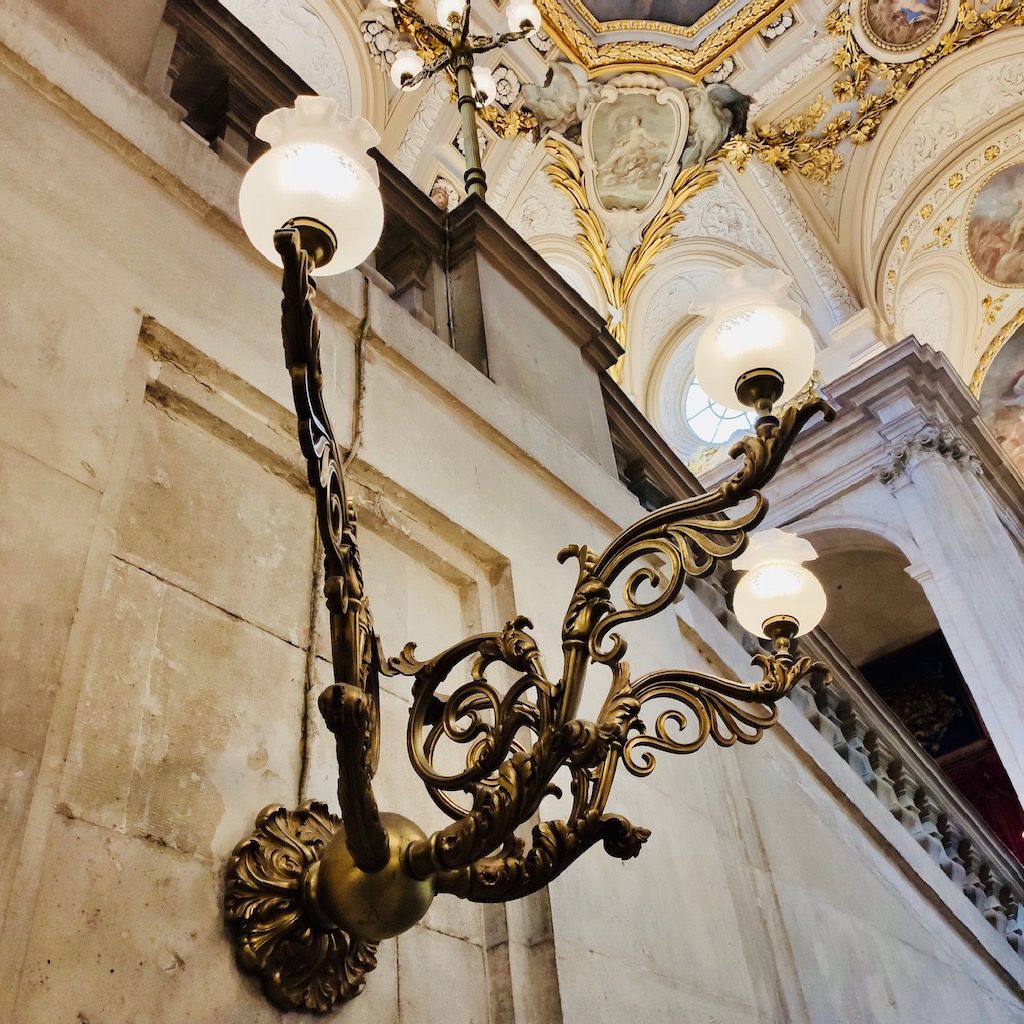

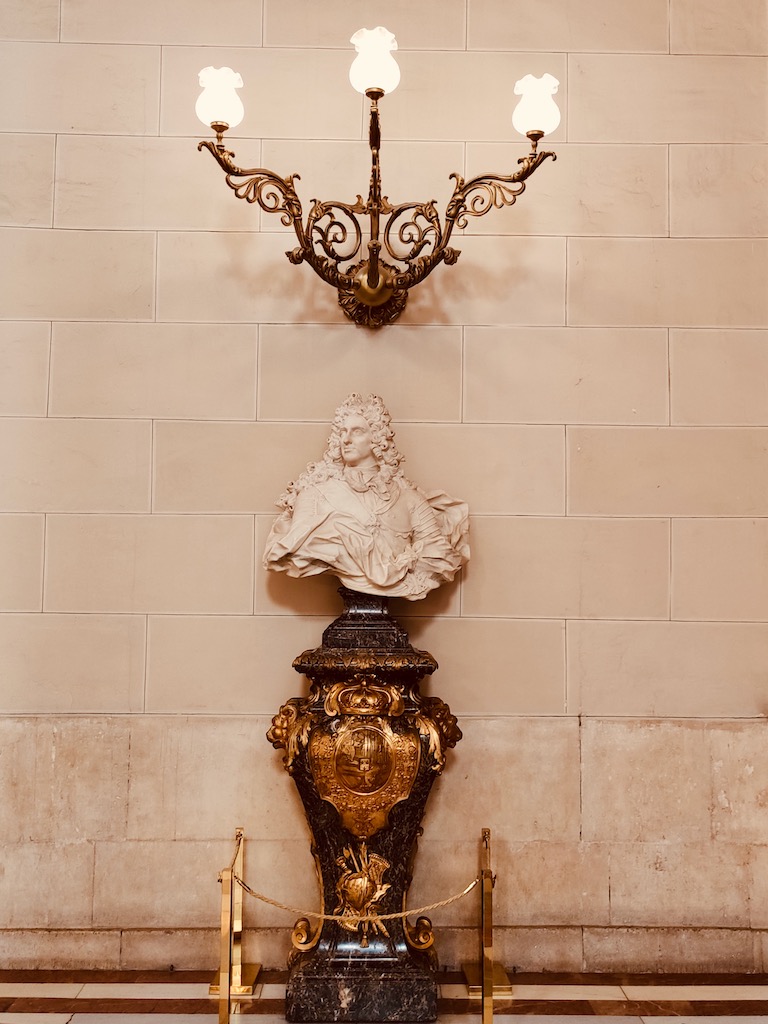

Salon Alabarderos or Hall of Halberdiers
The architect initially designed the room to be a dance and party salon. But King Charles III transformed it into a space for the guards. The decoration is simple and refined, mainly made up of Tuscan pilasters.
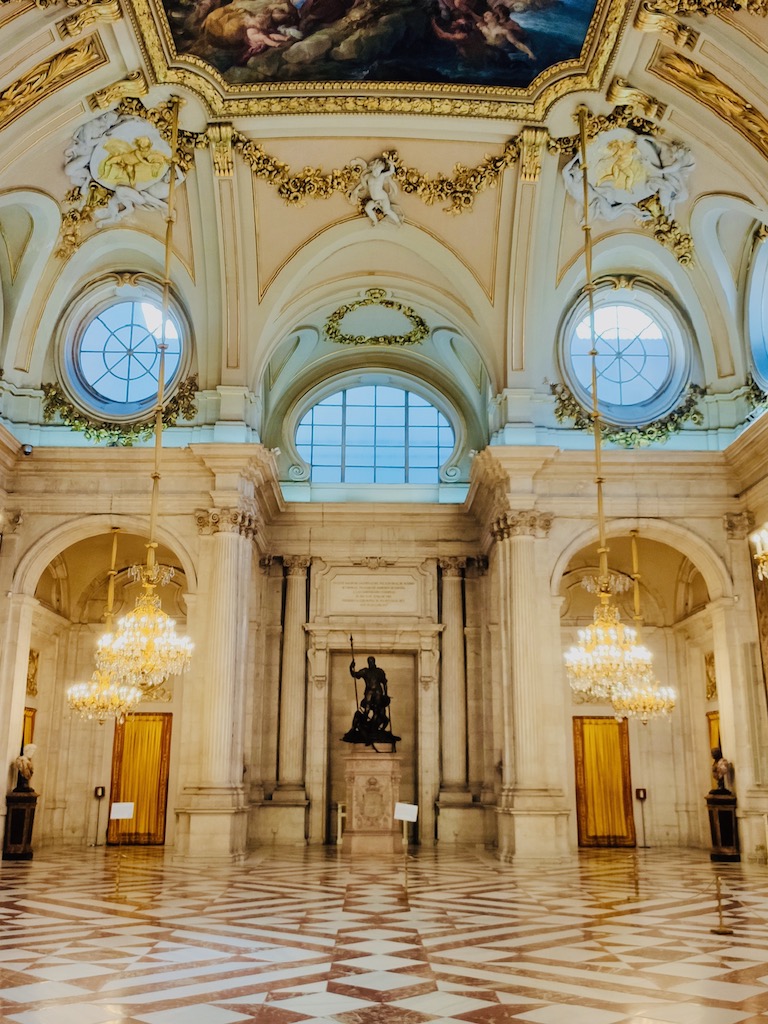

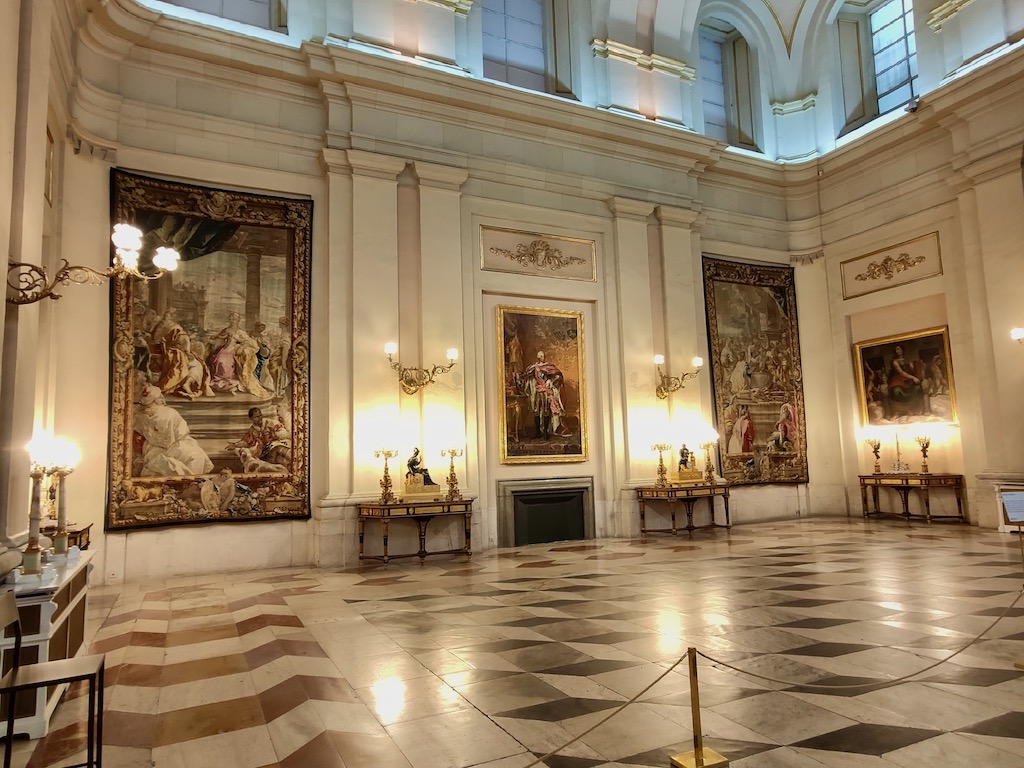

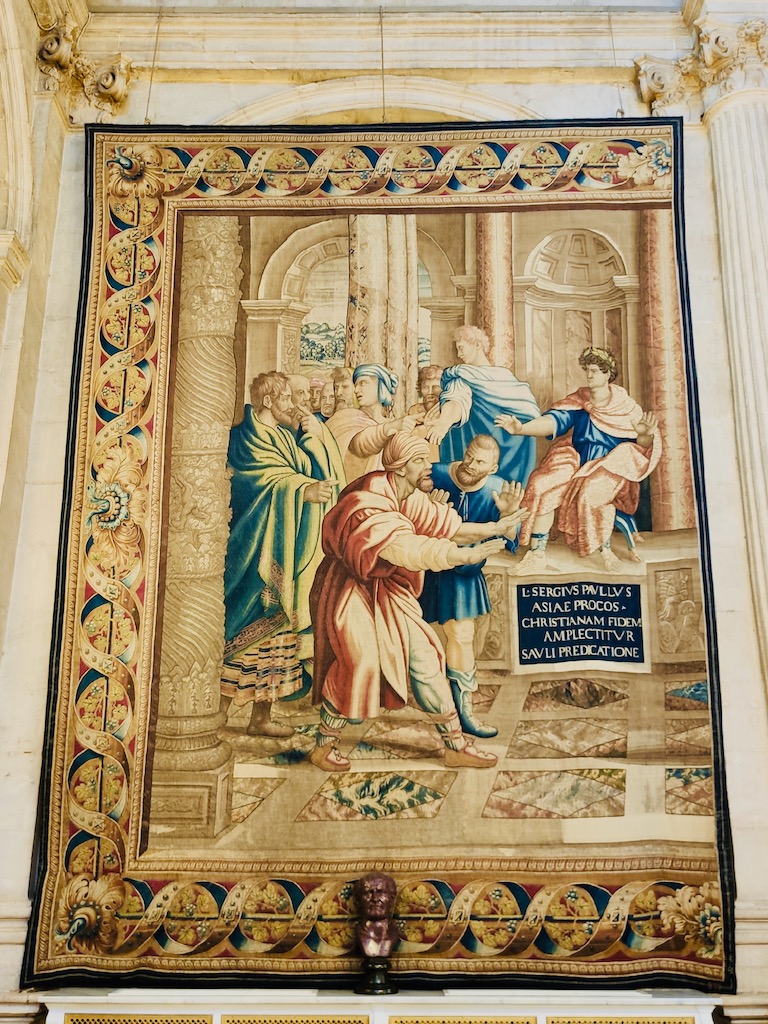

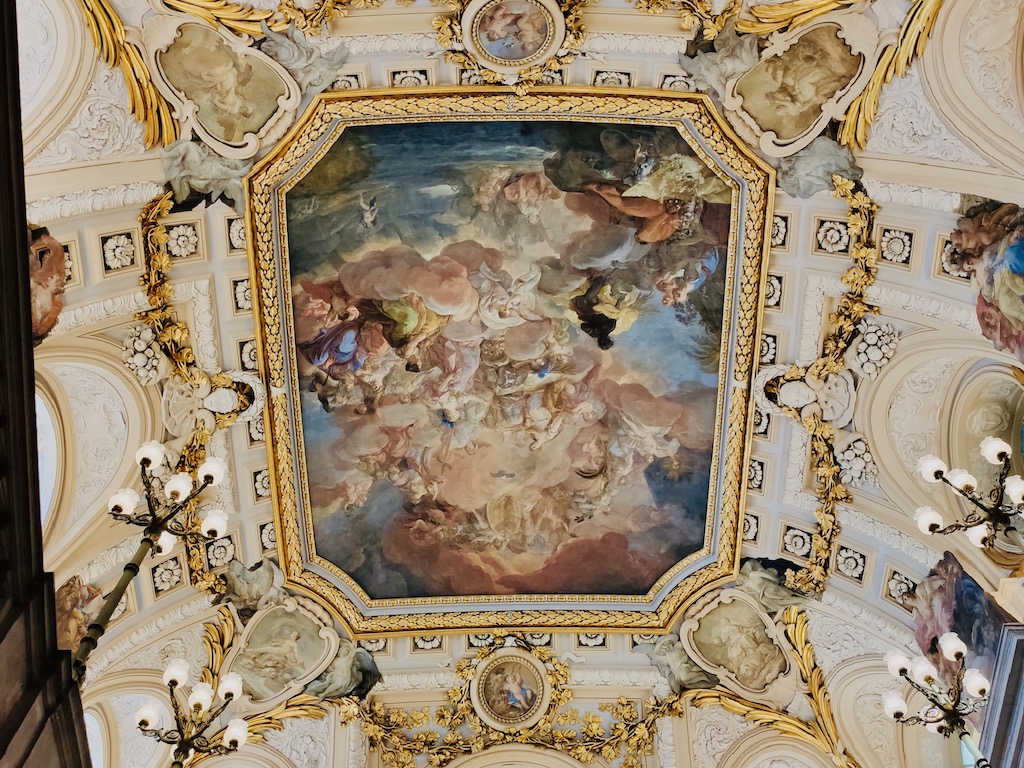

During one of his visits to Madrid, Napoleon would have said to the king: “Brother, you are going to have a much better house than mine.”
For us, the visit continues. As it is forbidden to take pictures in the royal apartments and the armory, here is the link to the royal palace site where you could admire these magnificent interiors.
The rooms that marked my visit
The throne room
The throne room has kept all the original decorations as it was completed in 1772 during Carlos III‘s reign.
In red and gold tones, it has just been completely restored. The cleaning of the fresco and the replacement of the velvet gave it back its former glory.
It is in this room that the sovereign holds all the ceremonial and official audiences.
The Royal Armoury
For me, the most beautiful and exceptional room of the visit.
The Royal Armoury is one of the jewels of Spain’s historical heritage. It is considered the most important in Europe.
The personal armor of Charles V and the arms and armor of Philippe II and Philippe III are the center of the collection. On the walls, the magnificent tapestries date from the 16th to the 18th Centuries.
The Hall of Columns
Originally designed as a ballroom and reception hall, it has become the seat of all civil ceremonies.
Today, royalty uses the room for public events. It was here that the abdication of King Juan Carlos I took place in favor of his son Felipe VI on June 18, 2014.
Gasparini Salon
It’s the room where the King’s dressing ceremony was held and where he received his private visits. It is indeed one of the most crucial rooms in the palace!
Its decoration is a mixture of chinoiserie and exuberant rococo style. Quite surprising and a little stuffy! The floor is in marble, the vault in stucco, the walls covered by hanging tapestries with threads of silk and gold and silver, and the furniture in precious wood and bronze — all in beige and brown tones.
Gala dining room
The Great Hall, reserved for significant events, dances, and gala, is now used for state dinners. It is possible to set up a table that can accommodate up to 150 guests.
We left the palace and took advantage of the late afternoon to stroll in the parks surrounding it.
Plaza de Oriente
Created in 1844, this rectangular-shaped square is located on the east side of the royal palace.
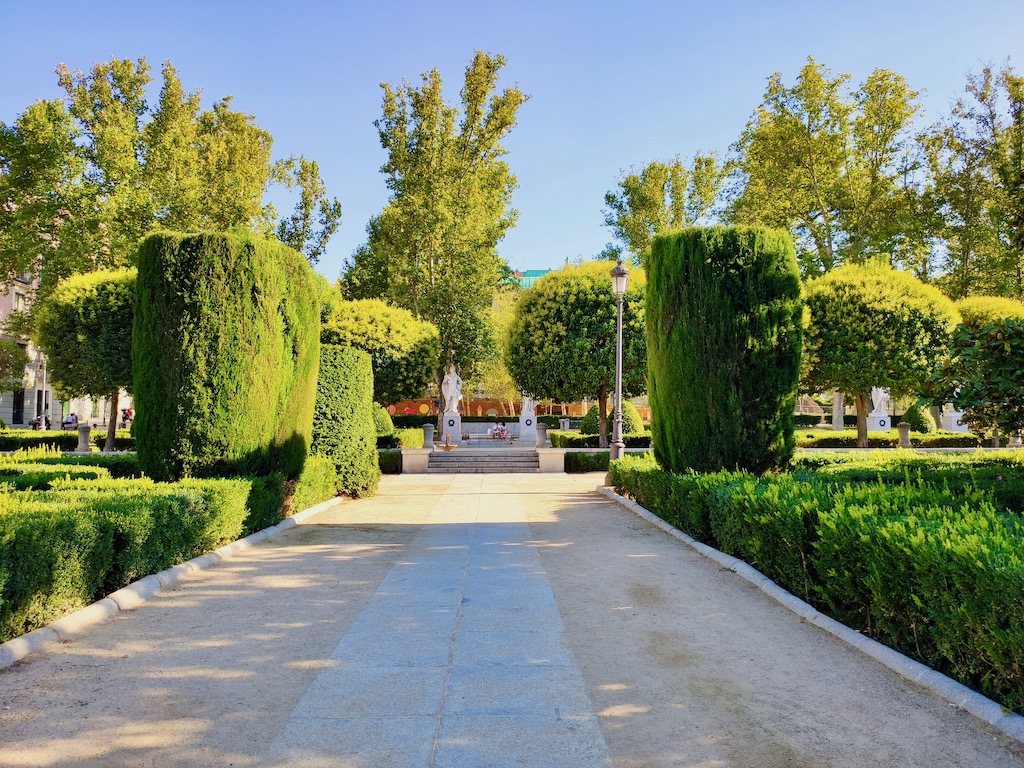

In the center of the square is one of the prominent sculptures, a bronze equestrian statue of Philip IV. This statue’s particularity is that it is the first statue of a horse standing on its hind legs.
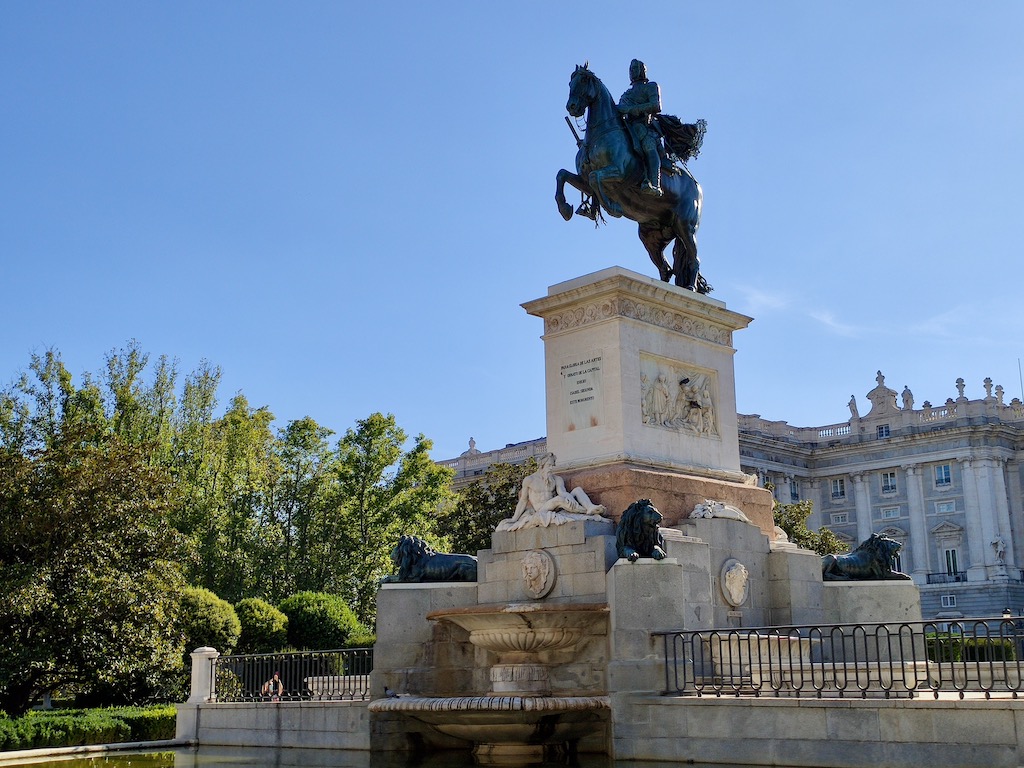

The sculptor Pietro Tacca, who made the sculpture from Velasquez‘s design, had to ask the great scientist Galileo Galilei for advice to guarantee its stability. The latter gave him the idea of resting the horse’s tail on the ground to ensure the third point of support and secure the monument’s balance.
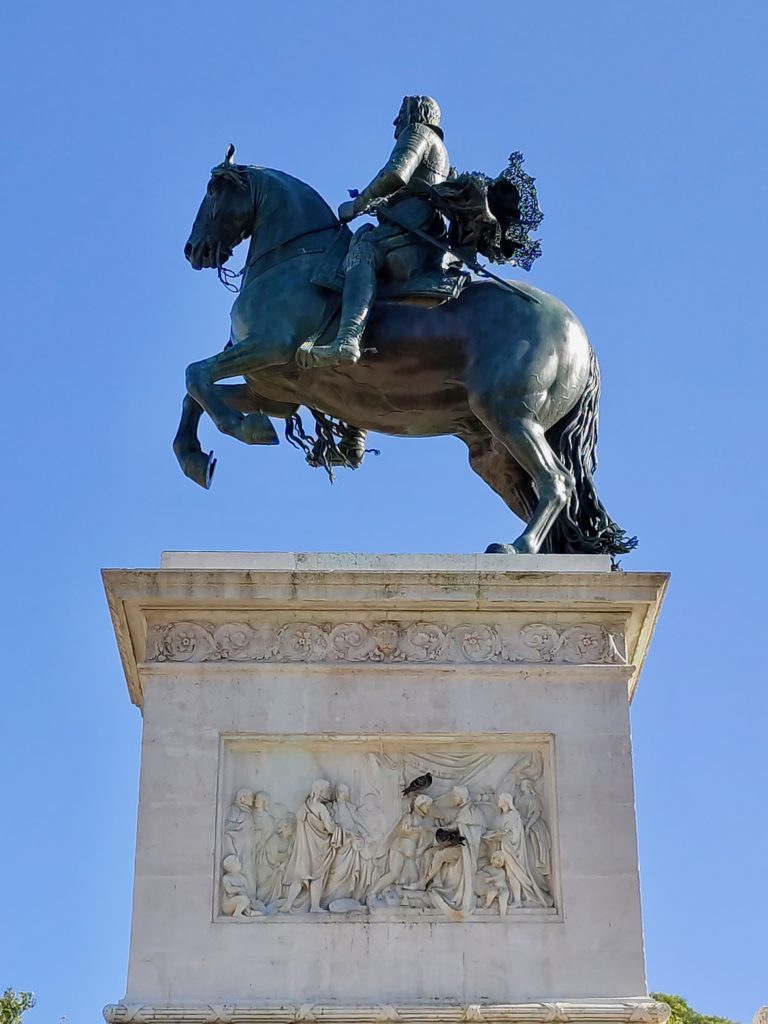

Why a prancing horse? This posture is an exception to The theory of equestrian statues. It was merely out of vanity. Philip IV wanted a more beautiful figure than his father, Philip III, on the Plaza Mayor.
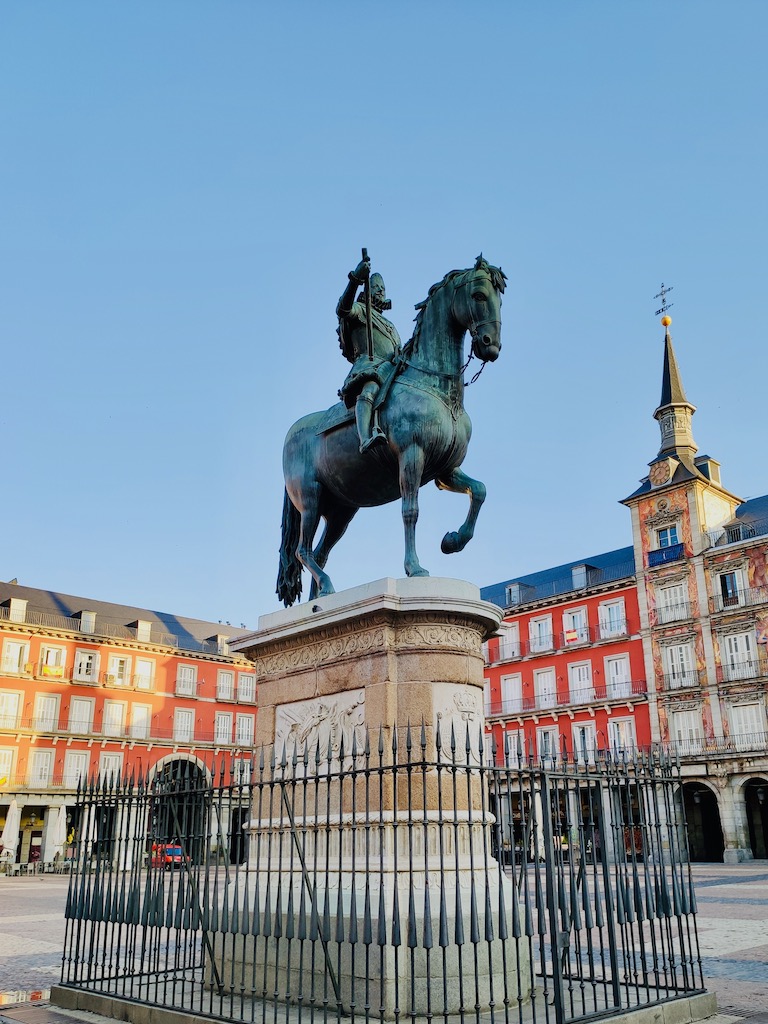

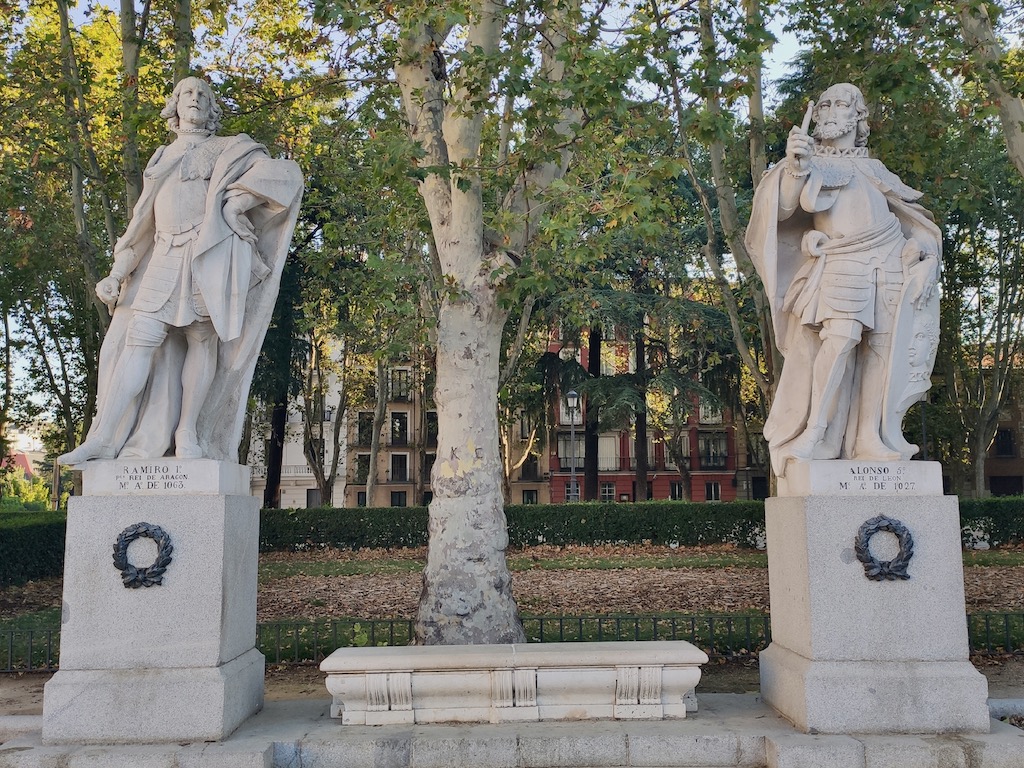

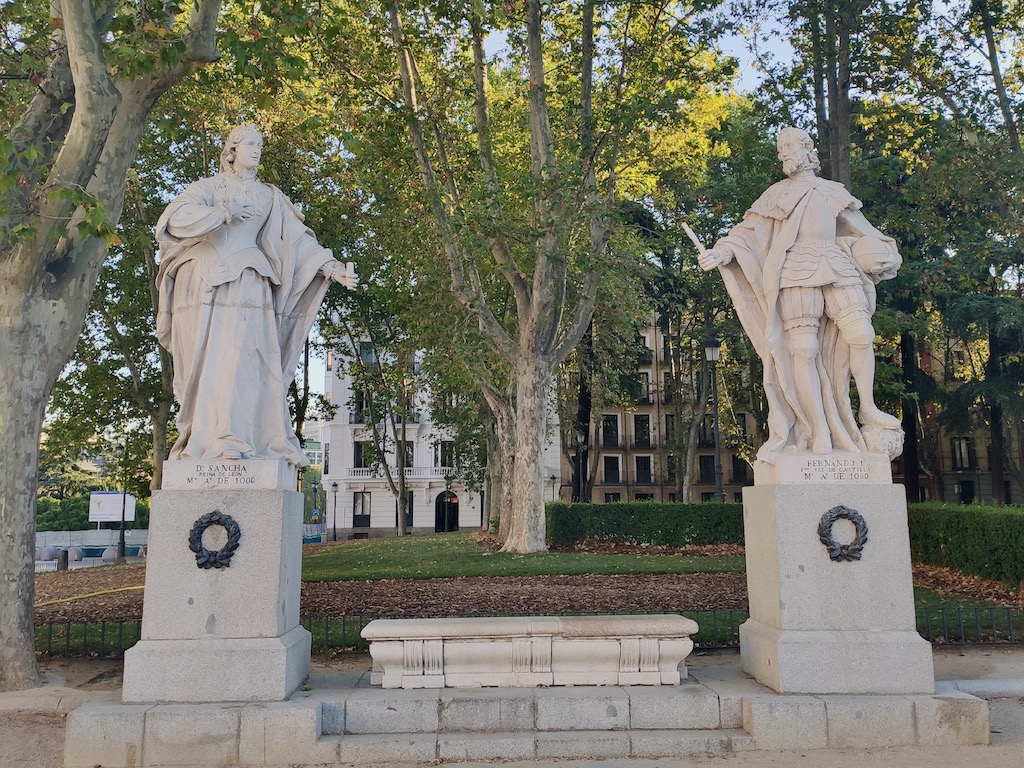

But these statues were not installed here initially. They were on the roof of the castle. So what happened?
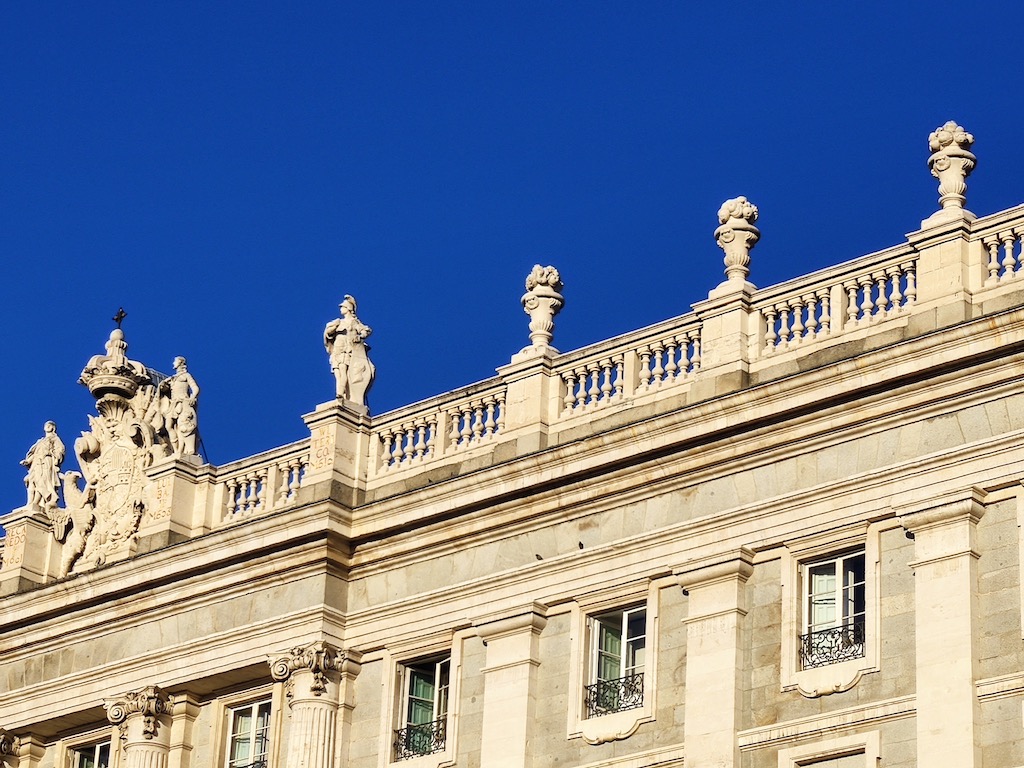

At the beginning of the 18th Century, Isabel de Farnesio, mother of Charles III, had nightmares about the statues falling from the roof and killing her. She then had them removed and stored in the palace’s basements.
They remained there until the 19th Century, when Isabel II decided to take them out to exhibit them again. But not on the roof anymore! They were instead placed in the Plaza de Oriente.
Sabatini Gardens
The Sabatini Gardens are part of Madrid’s Royal Palace and were opened to the public by King Juan Carlos I in 1978. They honor the 18th-century Italian architect Francesco Sabatini. It was at this location that the royal stables were located until 1933 until they were demolished to be replaced by this garden.
The garden is composed of three terraces with statues, fountains, and plant labyrinths and offers a spectacular view of the palace’s north facade.
Unfortunately, we couldn’t admire it, as it was closed due to renovation. We will have to come back. 😊
Campo del Moro
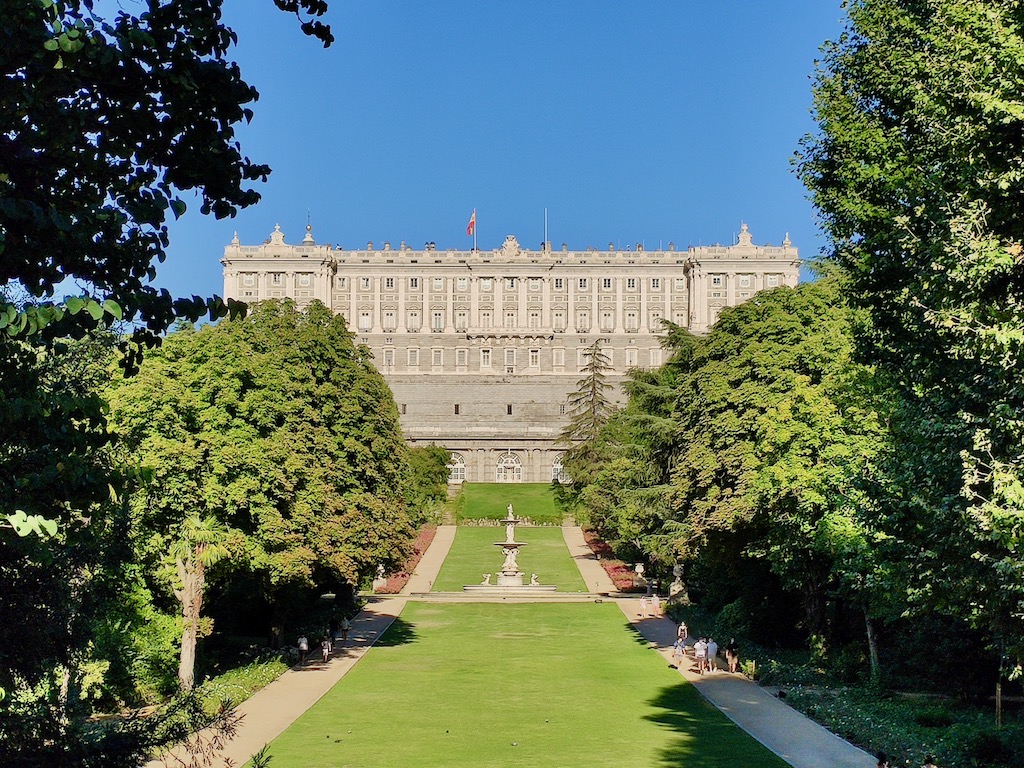

This expanse under the palace was not embellished until the second half of the 19th Century. If it had not until then been developed as such, it was due to the impossibility of directly connecting this site to the Royal Palace. They are indeed located at different levels, which prevents direct entry into the park from the palace. Despite this, Queen Maria Cristina decided to turn this site into an English garden.
Why its name, the Moors camp?
When in 1109, the Muslim leader Alí Ben Yusuf tried to reconquer Madrid after King Alfonso VI’s death, he attacked the fortress located on the hillside from what was then a vast field. They will also set up their camp there during the battle, which gave the place its name.
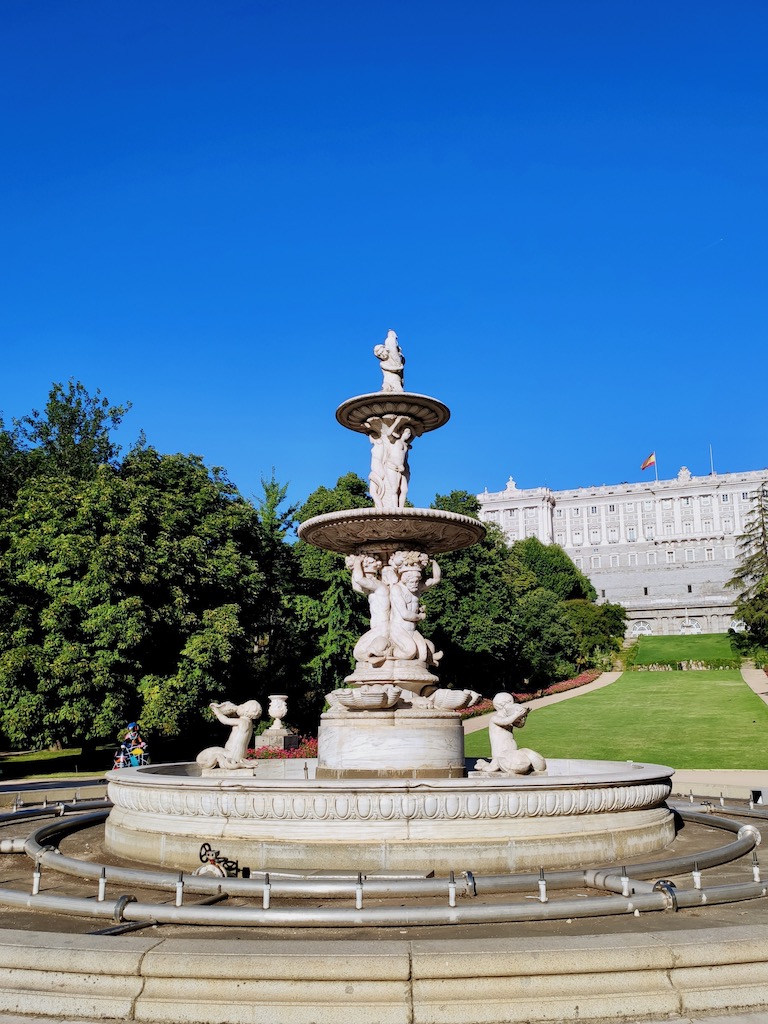

In 1931, the park was declared a Historic-Artistic Monument.
The visit of the park in pictures
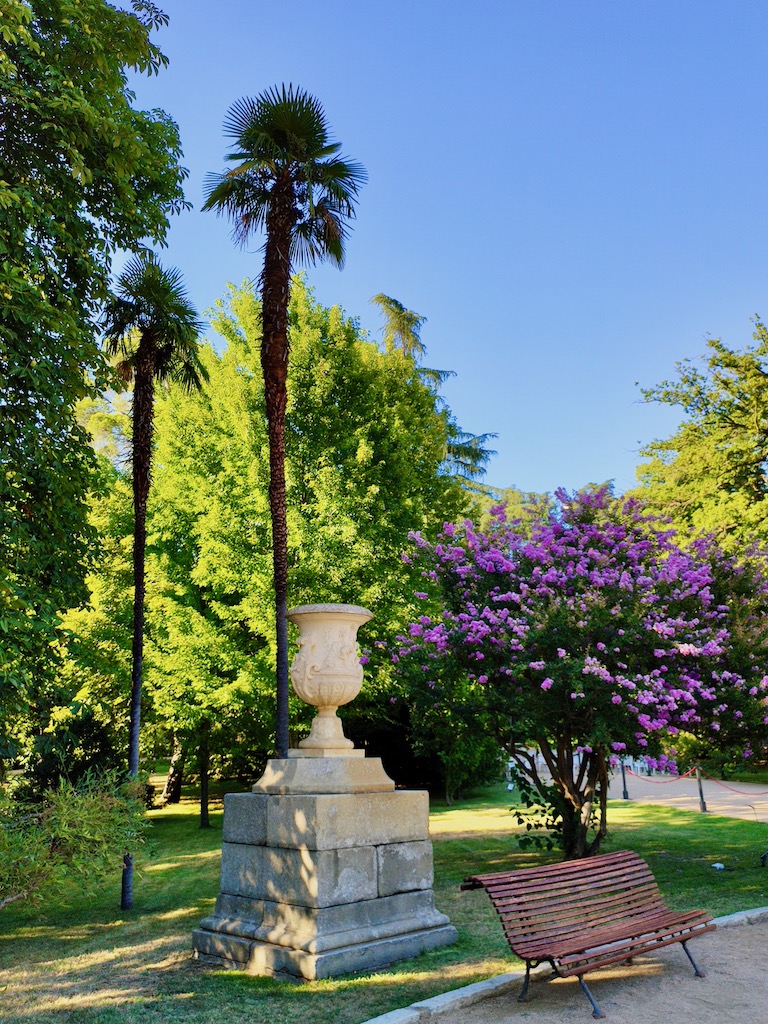

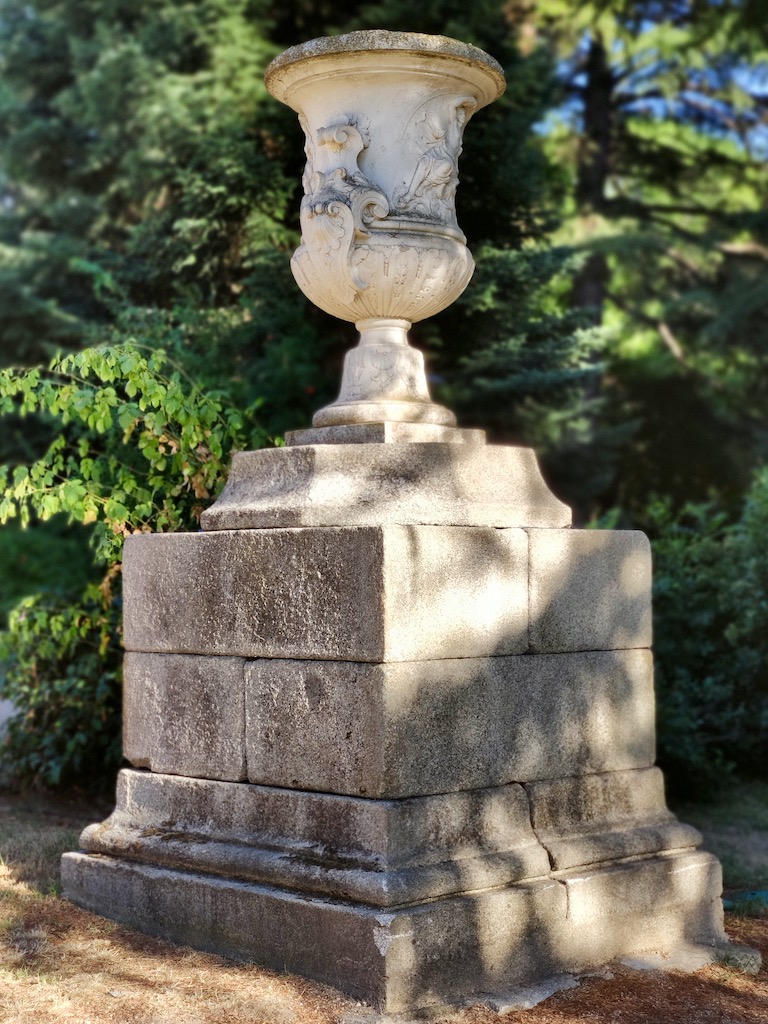

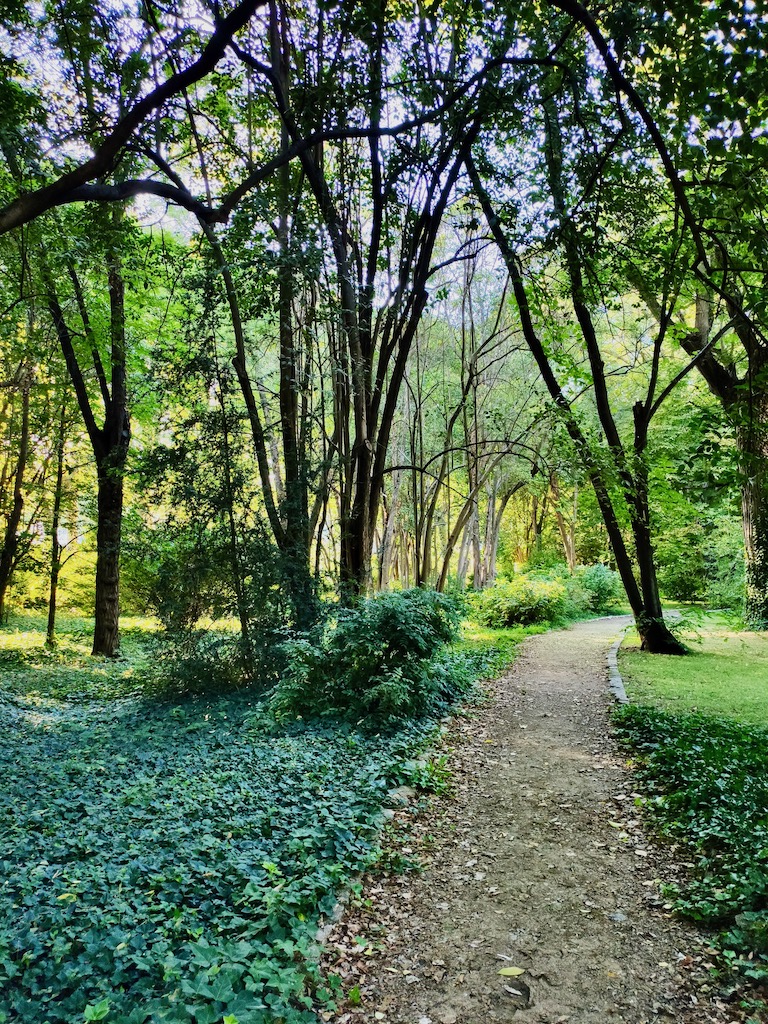

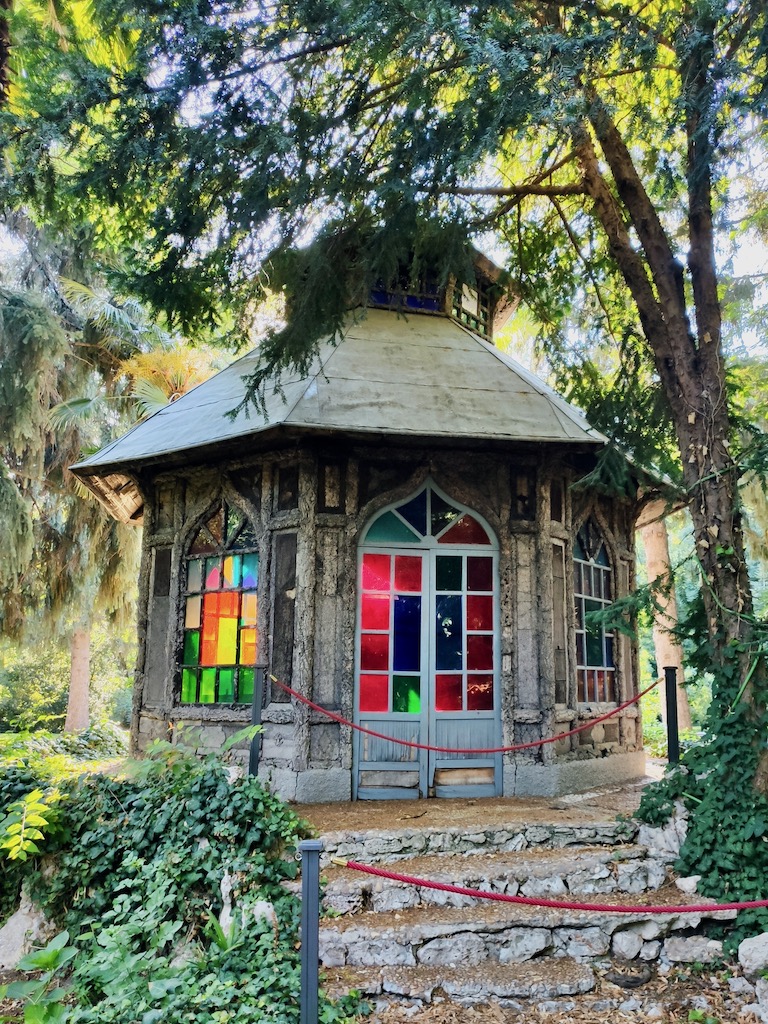

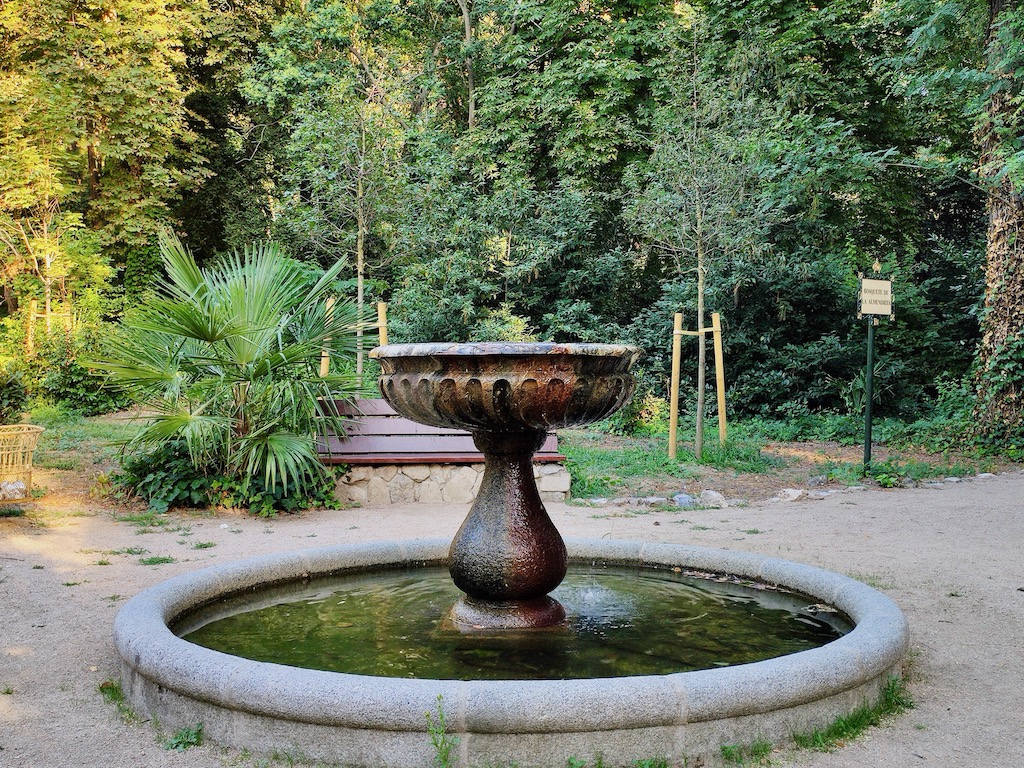

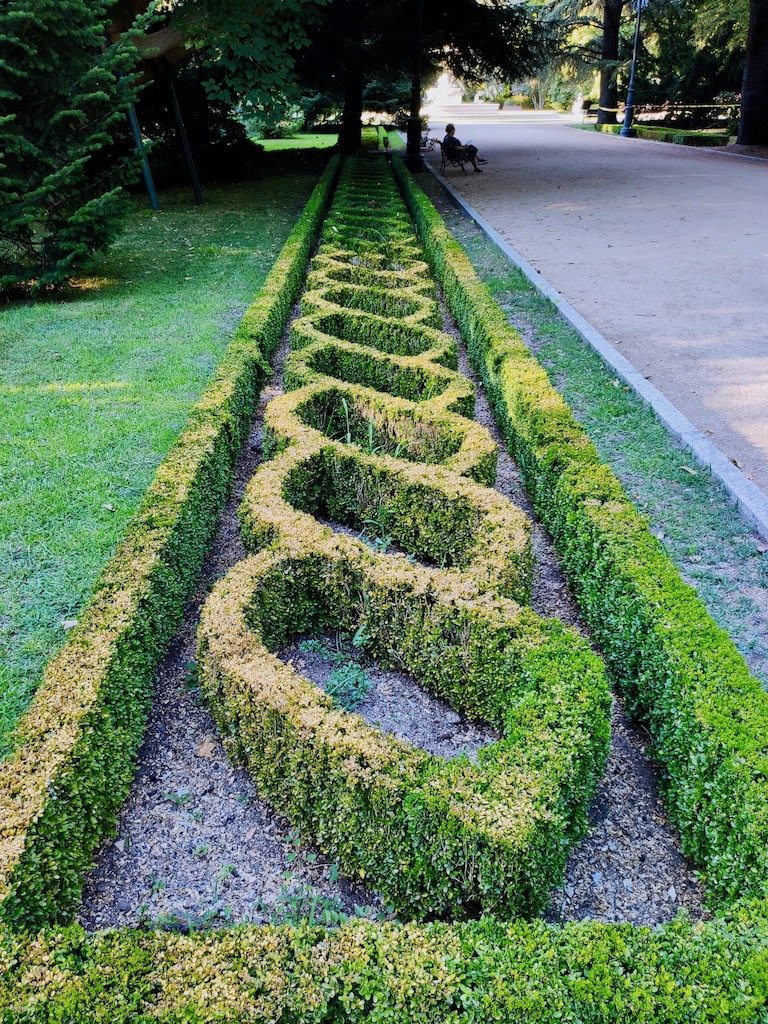

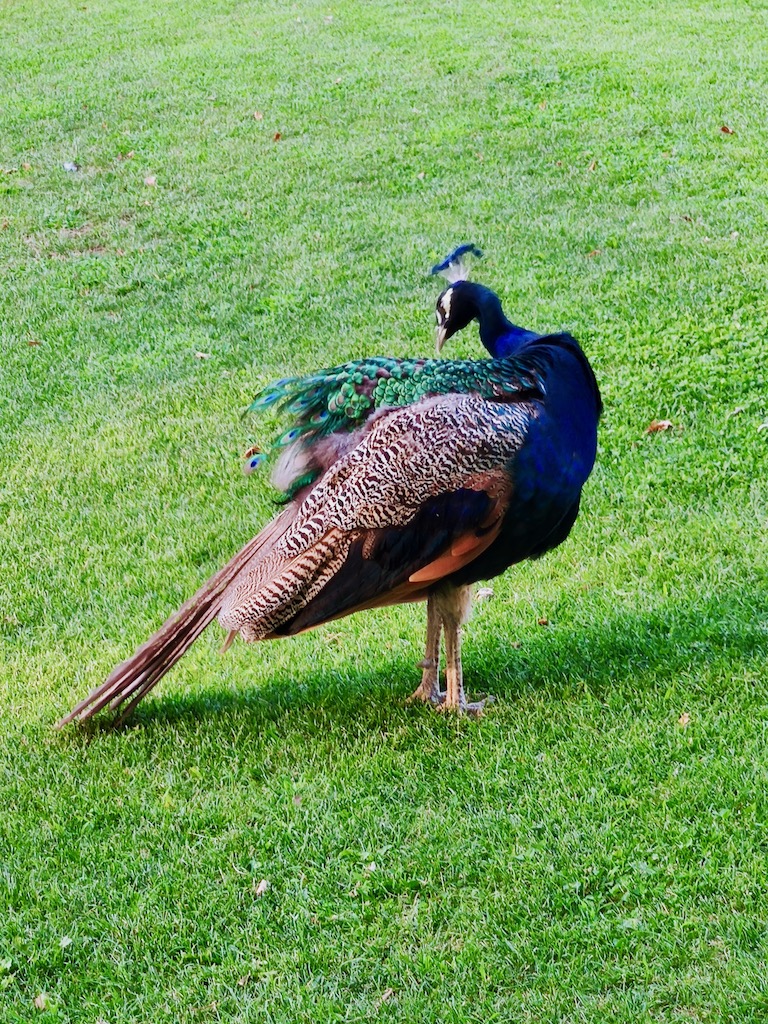

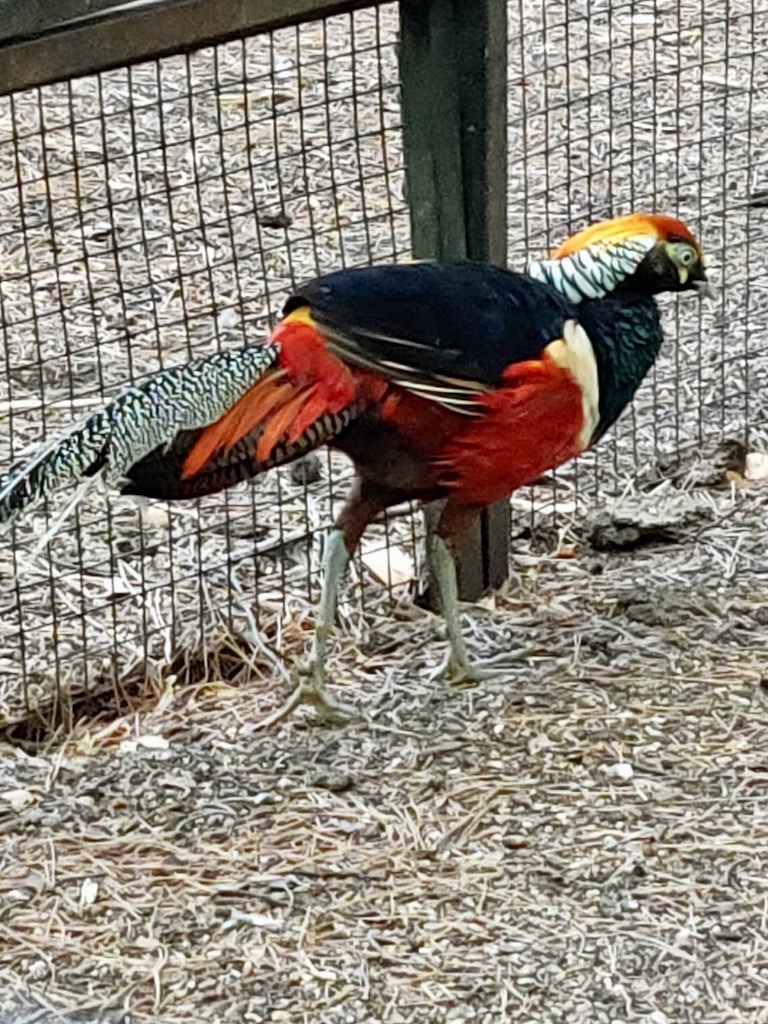

And we had the great surprise of seeing a magnificent golden pheasant!
Final point
This visit is a must-do in Madrid. The palace is outstanding, and the various rooms are all more incredible than the others.
Although it is still the residence of the kings of Spain, the current ruler, Felipe VI, and his family live at the Zarzuela Palace, which is on Madrid’s outskirts, near the Royal Palace of El Pardo, which hosts the visiting heads of state. It is also in this palace that the King has his offices. The royal palace is only used today for state ceremonies. One of the last was the wedding banquet of Prince Felipe and Letizia Ortiz, which took place on May 22, 2004, in the palace’s central courtyard.

Nice post! I’ve never visited Madrid before but I do love a good palace 🙂 very informative with great photos!
Thank you. One of the most beautiful palaces I’ve ever visited.